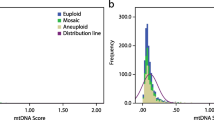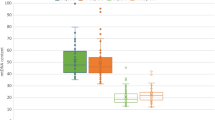Abstract
Objective
To evaluate the feasibility of adjusted mitochondrial DNA quantification in human embryos as a biomarker for implantation potential.
Design
Double-blind, observational, prospective analysis of an Asian population in a single university-affiliated in vitro fertilization center. A total of 1617 embryos derived from 380 infertile couples were collected. The DNA from blastomere biopsy (n = 99) or trophectoderm biopsy (n = 1518) were analyzed with next-generation sequencing.
Results
The adjusted mtDNA quantification followed a non-normal distribution in both types of the embryos. When stratified by ploidy status, the adjusted mtDNA quantification was significantly higher in aneuploid trophectoderm than in euploid cells, but not in blastomeres. The adjusted mtDNA quantification of embryos showed significant but very weak positive correlation in total trophectoderm cells with maternal age (Spearman’s correlation, r = 0.095, p = 0.0028) but neither in blastomeres nor stratified by ploidy status. The median adjusted mtDNA quantification was also significantly higher in aneuploid blastocysts than in euploid ones while corrected with embryo morphology. Viable embryos did not contain significantly different quantities of adjusted mtDNA compared with nonviable embryos (implanted n = 103, non-implanted n = 164; median 0.00097 vs. 0.00088, p = 0.21) in 267 transferred blastocysts.
Conclusion
Quantification of adjusted mitochondria DNA in human embryos was significantly lower in euploid blastocysts than in aneuploid blastocysts. However, no statistically significant differences regarding implantation outcome were evident. To our best knowledge, this study provides the largest scale and the first correlation data between mitochondria copy number and human embryo implantation potential in Asians.





Similar content being viewed by others
References
Chang J, Boulet SL, Jeng G, Flowers L, Kissin DM. Outcomes of in vitro fertilization with preimplantation genetic diagnosis: an analysis of the United States Assisted Reproductive Technology Surveillance Data, 2011–2012. Fertil Steril. 2016;105(2):394–400.
Fragouli E, Alfarawati S, Spath K, Jaroudi S, Sarasa J, Enciso M, et al. The origin and impact of embryonic aneuploidy. Hum Genet. 2013;132(9):1001–13.
Rosenwaks Z. Introduction: biomarkers of embryo viability: the search for the “holy grail” of embryo selection. Fertil Steril. 2017;108(5):719–21.
Zegers-Hochschild F, Adamson GD, Dyer S, Racowsky C, de Mouzon J, Sokol R, et al. The international glossary on infertility and fertility care, 2017. Fertil Steril. 2017;108(3):393–406.
Chan DC. Mitochondria: dynamic organelles in disease, aging, and development. Cell. 2006;125(7):1241–52.
Wai T, Ao A, Zhang X, Cyr D, Dufort D, Shoubridge EA. The role of mitochondrial DNA copy number in mammalian fertility. Biol Reprod. 2010;83(1):52–62.
May-Panloup P, Boucret L, Chao de la Barca JM, Desquiret-Dumas V, Ferré-L'Hotellier V, Morinière C, et al. Ovarian ageing: the role of mitochondria in oocytes and follicles. Hum Reprod Update. 2016;22(6):725–43.
St John JC, et al. Mitochondrial DNA transmission, replication and inheritance: a journey from the gamete through the embryo and into offspring and embryonic stem cells. Hum Reprod Update. 2010;16(5):488–509.
Hsieh R-H, Au HK, Yeh TS, Chang SJ, Cheng YF, Tzeng CR. Decreased expression of mitochondrial genes in human unfertilized oocytes and arrested embryos. Fertil Steril. 2004;81:912–8.
Hsieh R-H, Tsai NM, Au HK, Chang SJ, Wei YH, Tzeng CR. Multiple rearrangements of mitochondrial DNA in unfertilized human oocytes. Fertil Steril. 2002;77(5):1012–7.
Van Blerkom J. Mitochondria in human oogenesis and preimplantation embryogenesis: engines of metabolism, ionic regulation and developmental competence. Reproduction. 2004;128(3):269–80.
Fragouli E, Spath K, Alfarawati S, Kaper F, Craig A, Michel CE, et al. Altered levels of mitochondrial DNA are associated with female age, aneuploidy, and provide an independent measure of embryonic implantation potential. PLoS Genet. 2015;11(6):e1005241.
Diez-Juan A, Rubio C, Marin C, Martinez S, al-Asmar N, Riboldi M, et al. Mitochondrial DNA content as a viability score in human euploid embryos: less is better. Fertil Steril. 2015;104(3):534–41 e1.
Ravichandran K, et al. Mitochondrial DNA quantification as a tool for embryo viability assessment: retrospective analysis of data from single euploid blastocyst transfers. Hum Reprod. 2017:1–11.
Fragouli E, McCaffrey C, Ravichandran K, Spath K, Grifo JA, Munné S, et al. Clinical implications of mitochondrial DNA quantification on pregnancy outcomes: a blinded prospective non-selection study. Hum Reprod. 2017;32(11):2340–7.
Victor AR, Brake AJ, Tyndall JC, Griffin DK, Zouves CG, Barnes FL, et al. Accurate quantitation of mitochondrial DNA reveals uniform levels in human blastocysts irrespective of ploidy, age, or implantation potential. Fertil Steril. 2017;107(1):34–42 e3.
Treff NR, Zhan Y, Tao X, Olcha M, Han M, Rajchel J, et al. Levels of trophectoderm mitochondrial DNA do not predict the reproductive potential of sibling embryos. Hum Reprod. 2017:1–9.
Fiorentino F, Bono S, Biricik A, Nuccitelli A, Cotroneo E, Cottone G, et al. Application of next-generation sequencing technology for comprehensive aneuploidy screening of blastocysts in clinical preimplantation genetic screening cycles. Hum Reprod. 2014;29(12):2802–13.
Gardner DK, Lane M, Stevens J, Schlenker T, Schoolcraft WB. Blastocyst score affects implantation and pregnancy outcome: towards a single blastocyst transfer. Fertil Steril. 2000;73(6):1155–8.
Nasiri N, Eftekhari-Yazdi P. An overview of the available methods for morphological scoring of pre-implantation embryos in in vitro fertilization. Cell J. 2015;16(4):392–405.
Scott RT, et al. Blastocyst biopsy with comprehensive chromosome screening and fresh embryo transfer significantly increases in vitro fertilization implantation and delivery rates: a randomized controlled trial. Fertil Steril. 2013;100(3):697–703.
Rubio C, Bellver J, Rodrigo L, Castillón G, Guillén A, Vidal C, et al. In vitro fertilization with preimplantation genetic diagnosis for aneuploidies in advanced maternal age: a randomized, controlled study. Fertil Steril. 2017;107(5):1122–9.
Practice Committees of the American Society for Reproductive M, et al. The use of preimplantation genetic testing for aneuploidy (PGT-A): a committee opinion. Fertil Steril. 2018;109(3):429–36.
Capalbo A, Rienzi L, Cimadomo D, Maggiulli R, Elliott T, Wright G, et al. Correlation between standard blastocyst morphology, euploidy and implantation: an observational study in two centers involving 956 screened blastocysts. Hum Reprod. 2014;29(6):1173–81.
Minasi MG, Colasante A, Riccio T, Ruberti A, Casciani V, Scarselli F, et al. Correlation between aneuploidy, standard morphology evaluation and morphokinetic development in 1730 biopsied blastocysts: a consecutive case series study. Hum Reprod. 2016;31(10):2245–54.
de Los Santos MJ, et al. Variables associated with mitochondrial copy number in human blastocysts: what can we learn from trophectoderm biopsies? Fertil Steril. 2018;109(1):110–7.
Wells D. Mitochondrial DNA quantity as a biomarker for blastocyst implantation potential. Fertil Steril. 2017;108(5):742–7.
Humaidan P, Kristensen SG, Coetzee K. Mitochondrial DNA, a new biomarker of embryonic implantation potential: fact or fiction? Fertil Steril. 2018;109(1):61–2.
Viotti M, Victor AR, Zouves CG, Barnes FL. Is mitochondrial DNA quantitation in blastocyst trophectoderm cells predictive of developmental competence and outcome in clinical IVF? J Assist Reprod Genet. 2017;34(12):1581–5.
Scott RT Jr. Enhanced techniques to “power” embryonic mitochondria research. Fertil Steril. 2017;107(1):59–60.
Barritt JA, K.M., Cohen J, Steuerwald N, Brenner CA, Quantification of human ooplasmic mitochondria. Reprod BioMed Online, 2002. 4: p. 243–247.
Lin D. Comparison of mitochondrial DNA contents in human embryos with good or poor morphology at the 8-cell stage. Fertil Steril. 2004;81(1):73–9.
Eichenlaub-Ritter U, Wieczorek M, Lüke S, Seidel T. Age related changes in mitochondrial function and new approaches to study redox regulation in mammalian oocytes in response to age or maturation conditions. Mitochondrion. 2011;11(5):783–96.
Tsai T, John JCS. The role of mitochondrial DNA copy number, variants, and haplotypes in farm animal developmental outcome. Domest Anim Endocrinol. 2016;56:S133–46.
Acknowledgments
The authors thank all the embryologists of the reproductive center of Taipei Medical University Hospital for embryo biopsy and sample preparation. We also thank the bioinformatics support provided by the Genomics Center for Clinical and Biotechnological Applications of the National Yang-Ming University VGH Genome Research Center. Genomics Center for Clinical and Biotechnological Applications is supported by the National Core Facility for Biopharmaceuticals, Ministry of Science and Technology. We also thank the Taipei Medical University Hospital for financial support. Finally, we thank the Genetics Generation Advancement Corporation for supporting this study in various forms, including sample preparation and interpretation, technical support, and extremely helpful discussions.
Funding
This study was partially supported by research grants NSC96-2314-B-038-019 and MOST-104-2314-B-038-063-MY2 from the Ministry of Science and Technology, Taiwan, Academia Sinica (BM10501010036, BM10601010024), National Healthy Research Institute (MG-1050SP-07, MG-106-SP-07), and Taipei Medical University Hospital (108TMUH-NE-01). The funders played no role in the conduct of the study or the writing of the manuscript.
Author information
Authors and Affiliations
Corresponding author
Ethics declarations
This study was reviewed and approved by the Taipei Medical University joint institutional review board (TMU-JIRB, approval number: N201707027). Patient informed consent for analysis of surplus DNA product was obtained with the approval of the ethical committee.
Conflict of interest
Dr. Yi-Hui Lin serves as a medical consultant for Genetics Generation Advancement Corporation. The other authors declare that they have no conflict of interest.
Additional information
Publisher’s note
Springer Nature remains neutral with regard to jurisdictional claims in published maps and institutional affiliations.
Rights and permissions
About this article
Cite this article
Lee, YX., Chen, CH., Lin, SY. et al. Adjusted mitochondrial DNA quantification in human embryos may not be applicable as a biomarker of implantation potential. J Assist Reprod Genet 36, 1855–1865 (2019). https://doi.org/10.1007/s10815-019-01542-6
Received:
Accepted:
Published:
Issue Date:
DOI: https://doi.org/10.1007/s10815-019-01542-6




